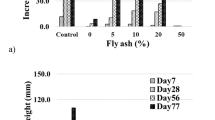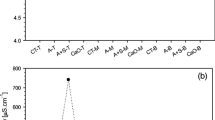Abstract
The impact of plants (Phalaris arundinacea L.) on the leakage of ammonium, cadmium, copper, nitrate, phosphate, and zinc from sulfidic mine tailings covered with wood fly ash and sewage sludge was investigated. Either ash or sludge was placed in contact with the tailings, and ash layers of either low or high compactness were used. It was revealed that an ash/sludge cover effectively decreased the metal leaching from the tailings regardless of the order in which the materials were applied. Plants decreased the amount of leachate and the concentrations of ammonium and phosphate. The presence of ash below the sludge decreased the plant uptake of copper and zinc and nitrate leakage. However, when the ash was added as a thin (1.5 cm) porous layer, roots and air reached the tailings and caused high metal leakage. The results support the use of a vegetated ash/sludge cover in the treatment of mine tailings, provided that the sealing layer is firm enough to prevent root penetration.



Similar content being viewed by others
References
APHA, AWWA, WEF. (1995). Standard methods for the examination of water and wastewater (19th ed.). American Public Health Association. Washington DC, USA.
Bengough, A. G., & Mullins, C. E. (1990). Mechanical impedance to root growth: A review of experimental techniques and root growth responses. Journal of Soil Science, 41, 341–358.
Brown, S. L., Henry, C. L., Chaney, R., Compton, H., & DeVolder, P. S. (2003). Using municipal biosolids in combination with other residuals to restore metal-contaminated mining areas. Plant and Soil, 249, 203–215.
Burckhard, S. R., Schwab, A. P., & Banks, M. K. (1995). The effect of organic acids on the leaching of heavy metals from mine tailings. Journal of Hazardous Materials, 41, 135–145.
Clemensson-Lindell, A., Borgegård, S.-O., & Persson, H. (1992). Reclamation of mine waste and its effects on plant growth and root development—A literature review. Swedish University of Agricultural Sciences, Dept of Ecology and Environmental Research, Report 47. Sweden
Cravotta, C. A., III. (1998). Effect of sewage sludge on formation of acidic ground water at a reclaimed coal mine. Ground Water, 35(6), 9–19.
Crommentuijn, T., Doornekamp, A., & Van Gestel, C. A. M. (1997). Bioavailability and ecological effects of cadmium on Folsomia candida (Willem) in an artificial soil substrate as influenced by pH and organic matter. Applied Soil Ecology, 5, 261–271.
Elander, P., Lindvall, M., & Håkansson, K. (1998). MiMi—Prevention and control of pollution from mining waste products. State-of-the-art-report. MiMi 2.
Evanylo, G. K., Abaye, A. O., Dundas, C., Zipper, C. E., Lemus, R., Sukkariyah, B., et al. (2005). Herbaceous vegetation productivity, persistence and metal uptake on a biosolids-amended mine soil. Journal of Environmetnal Quality, 34, 1811–1819.
Gibert, O., de Pablo, J., Cortina, J. L., & Ayora, C. (2004). Chemical characterisation of natural organic substrates for biological mitigation of acid mine drainage. Water Research, 38, 4186–4196.
Greger, M., & Landberg, T. (1999). Use of willow in phytoextraction. International Journal of Phytoremediation, 1(2), 115–23.
Gregory, P. J. (2006). Roots, rhizosphere and soil: The route to a better understanding of soil science? European Journal of Soil Science, 57, 2–12.
Hallberg, R. O., Granhagen, J. R., & Liljemark, A. (2005). A fly ash/biosludge dry cover for the mitigation of AMD at the falun mine. Chemie der Erde, 65(S1), 43–63.
Hasselgren, K. (1998). Use of municipal waste products in energy forestry: Highlights from 15 years of experience. Biomass and Bioenergy, 15, 71–74.
Holmström, H. (2000). Geochemical processes in sulphidic mine tailings: Field and laboratory studies performed in Northern Sweden at the Laver, Stekenjokk and Kristineberg Mine Sites. Doctoral thesis 2000:03, Luleå University of Technology, Luleå, Sweden.
Holtzclaw, K. M., Keech, D. A., Page, A. L., Sposito, G., Ganje, T. J., & Ball, N. B. (1978). Trace metal distributions among the humic acid, the fulvic acid, and precipitable fractions extracted with HaOH from sewage sludges. Journal of Environmental Quality, 7(1), 124–127.
Kumpiene, J., Lagerkvist, A., & Maurice, C. (2007). Stabilization of Pb- and Cu-contaminated soil using coal fly ash and peat. Environmental pollution, 145(1), 365–373.
Lindeman, W. (1958). Observations on the behaviour of phosphate compounds in Chlorella at the transition from dark to light. Proceedings 2nd International Conference of the United Nations on the Peaceful Uses of Atomic Energy, 24, 8–15.
Murphy, J., & Riley, J. P. (1962). A modified single-solution method for the determination of phosphate in natural waters. Analytica Chimica Acta, 27, 31–36.
Neuschütz, C., Stoltz, E., & Greger, M. (2006). Root penetration of sealing layers of fly ash and sewage sludge. Journal of Environmental Quality, 35, 1260–1268.
NRC (National Research Council). (2005). Mineral tolerance of animals (2nd ed.). Washington: National Academies.
Peppas, A., Komnitsas, K., & Halikia, I. (2000). Use of organic covers for acid mine drainage control. Minerals Engineering, 13(5), 563–574.
Pérez-López, R., Nieto, J. M., & Almodóvar, G. R. (2007). Utilization of fly ash to improve the quality of the acid mine drainage generated by oxidation of a sulphide-rich mining waste: Column experiments. Chemosphere, 67(8), 1637–1646.
Petersen, S. O., Petersen, J., & Rubak, G. H. (2003). Dynamic and plant uptake of nitrogen and phosphorus in soil amended with biosolids. Applied Soil Ecology, 24, 187–195.
Pilon-Smits, E. (2005). Phytoremediation. Annual Review of Plant Biology, 56, 15–39.
Ribet, I., Ptacek, C. J., Blowes, D. W., & Jambor, J. L. (1995). The potential for metal release by reductive dissolution of weathered mine tailings. Journal of Contaminant Hydrology, 17, 239–273.
Rimstidt, J. D., & Vaughan, D. J. (2003). Pyrite oxidation: A state-of-the-art assessment of the reaction mechanism. Geochimica et Cosmochimica Acta, 67(5), 873–880.
SMHI (Swedish Meteorological and Hydrological Institute). (2008). Annual average precipitation in Sweden 1961–1990. http://www.smhi.se/cmp/jsp/polopoly.jsp?d=7618&a=21514&l=sv Accessed 26 September 2008.
Santibáñez, C., Ginocchio, R., & Varnero, M. T. (2007). Evaluation of nitrate leaching from mine tailings amended with biosolids under Mediterranean type climate conditions. Soil Biology and Biochemistry, 39, 1333–1340.
Séguin, V., Gagnin, C., & Courchesne, F. (2004). Changes in water extractable metals, pH and organic carbon concentrations at the soil–root interface of forested soils. Plant and Soil, 260, 1–17.
SEPA (Swedish Environmental Protection Agency). (1999). Environmental quality criteria for agricultural landscapes (In Swedish). Report 4916, Swedish Environmental Protection Agency, Stockholm, Sweden.
Sopper, W. E. (1993). Municipal sludge use in land reclamation. Boca Raton: Lewis.
StatSoft, Inc. (2008). STATISTICA (data analysis software system), version 8.0. www.statsoft.com.
Steenari, B.-M., Schelander, S., & Lindqvist, O. (1999). Chemical and leaching characteristics of ash from combustion of coal, peat and wood in a 12 MW CFB—A comparative study. Fuel, 78, 249–258.
Stehouwer, R., Day, R. L., & Macneal, K. E. (2006). Nutrient and trace element leaching following mine reclamation with biosolids. Journal of Environmental Quality, 35, 1118–1126.
Stjernman Forsberg, L., & Ledin, S. (2006). Effects of sewage sludge on pH and plant availability of metals in oxidizing sulphide mine tailings. Science of the Total Environment, 358, 21–35.
Stoltz, E., & Greger, M. (2002). Cottongrass effects on trace elements in submersed mine tailings. Journal of Environmental Quality, 31, 1477–1483.
Stuczynski, T., Siebielec, G., Daniels, W. L., McCarty, G., & Chaney, R. L. (2007). Biological aspects of metal waste reclamation with biosolids. Journal of Environmental Quality, 36, 1154–1162.
Theodoratos, P., Moirou, A., Xenidis, A., & Paspaliaris, I. (2000). The use of municipal sewage sludge for the stabilization of soil contaminated by mining activities. Journal of Hazardous Materials, B77, 177–191.
Topaç, F. O., Başkaya, H. S., & Alkan, U. (2008). The effects of fly ash incorporation on some available nutrient contents of wastewater sludges. Bioresource Technology, 99(5), 1057–1065.
Venendaal, R., Jørgensen, U., & Foster, C. A. (1997). European energy crops: A synthesis. Biomass and Bioenergy, 13(3), 147–185.
Villar, L. D., & Garcia, O., Jr. (2002). Solubilization profiles of metal ions from bioleaching of sewage sludge as a function of pH. Biotechnology Letters, 24, 611–614.
Wang, C., Hu, X., Chen, M.-L., & Wu, Y.-H. (2005). Total concentrations and fractions of Cd, Cr, Pb, Cu, Ni and Zn in sewage sludge from municipal and industrial wastewater treatment plants. Journal of Hazardous Materials, B119, 245–249.
Wong, J. W. C., & Su, D. C. (1997). The growth of Agropyron elongatum in an artificial soil mix from coal fly ash and sewage sludge. Bioresource Technology, 59, 57–62.
Acknowledgments
These studies are included in a program supported by Boliden Mineral AB, Stockholm Vatten, The Swedish Water & Waste Water Association, and Värmeforsk. The authors are also most grateful to Anders Sjösten for help with analysis of N and C in the sewage sludge and to Prof. Lena Kautsky for valuable comments on the manuscript.
Author information
Authors and Affiliations
Corresponding author
Rights and permissions
About this article
Cite this article
Neuschütz, C., Greger, M. Stabilization of Mine Tailings Using Fly Ash and Sewage Sludge Planted with Phalaris arundinacea L.. Water Air Soil Pollut 207, 357–367 (2010). https://doi.org/10.1007/s11270-009-0142-5
Received:
Accepted:
Published:
Issue Date:
DOI: https://doi.org/10.1007/s11270-009-0142-5




